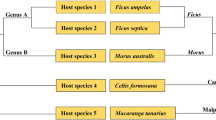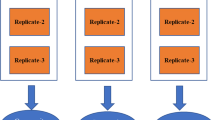Abstract
We investigated the microfungal assemblages in the decomposing tissues of dominant plant species in two peatlands in southern boreal Alberta, Canada, to determine if distinct patterns of succession of microfungi occurred throughout the first two years of decomposition. These plant species were Sphagnum fuscum from a bog and Carex aquatilis leaves and rhizomes and Salix planifolia leaves and roots from a riverine, sedge-dominated fen. Canonical correspondence analyses, a multivariate statistical analysis used infrequently in mycological research, revealed distinct patterns of fungal species succession in two of the five litters (S. fuscum and C. aquatilis leaves). Furthermore, our analyses showed that substantially different microfungal assemblages were associated with these litters within the first two years of decomposition. Litter quality variables, such as total nitrogen, total phosphorus, and total carbon tissue nutrient concentrations, explained most of the succession patterns and differences in the microfungal assemblages of these five litters. Our data did not reveal the classical taxonomic zygomycete – ascomycete/fungi imperfecti – basidiomycete pattern of succession during organic matter decomposition. Similarly, a succession of functional groups of microfungi, i.e., cellulose-degraders preceding lignin-degraders, generally was not apparent. Instead, microfungi with broad spectra of enzymatic abilities co-existed over the first two years of decomposition in these peatland plant litters. These microfungi have a limited ability to decompose complex phenolic polymers, such as lignin, resulting in the accumulation of peat in these ecosystems. Some microfungal taxa were not affected by changes in litter quality, environmental variables, or surface water chemistry and were present at all stages of decomposition.
Similar content being viewed by others
References
Apinis A E, Chester C G C and Taligoola H K 1972 Colonisation of Phragmites communis leaves by fungi. Nova Hedwig. 23, 113–124.
Cabral D, Stone J F and Carroll G C 1993 The internal mycobiota of Juncus spp.: microscopic and cultural observations of infection patterns. Mycol. Res. 97, 367–376.
Christensen M and Whittingham W F 1965 The soil microfungi in open bogs and conifer swamps in Wisconsin. Mycologia 57, 882–896.
Czastukhin V Y 1967 Decomposition of peat mosses by fungi. Mikol. Fitopatol. 1, 294–303.
Deacon J W 1997 Modern Mycology, 3rd edn. Blackwell Scientific Publications, Boston. 303 pp.
Dix N J 1985 Changes in relationship between water content and water potential after decay and its significance for fungal successions. Trans. Brit. Mycol. Soc. 85, 649–653.
Dooley M and Dickinson C H 1971 The ecology of fungi in peat. Ir. J. Agric. Res. 10, 195–206.
Ecoregions Working Group 1989 Ecoclimatic Regions of Canada, First Approximation. Canada Committee on Ecological Land Classification, Ecological Land Series, No. 23. Sustainable Development Branch, Canadian Wildlife Service, Conservation and Protection, Environment Canada, Ottawa. 452 pp.
Environment Canada 1998 Canadian Climate Normals, 1961–1990, Canadian Climate Program, Ottawa. http://www.cmc.ec.gc.ca/climate/normal s/e_al_ndx.htm.
Frankland J C 1966 Succession of fungi on decaying petioles of Pteridium aquilium. J. Ecol. 54, 41–63.
Harley J L and Waid J S 1955 A method of studying active mycelia on living roots and other surfaces in the soil. Trans. Brit. Mycol. Soc. 38, 104–118.
Harper J L and Webster J 1964 An experimental analysis of the coprophilous fungus succession. Trans. Brit. Mycol. Soc. 47, 511–530.
Heilmann-Clausen J 2001 A gradient analysis of communities of macrofungi and slime molds on decaying beech logs. Mycol. Res. 195, 575–596.
Hutchison L J 1990 Studies on the systematics of ectomycorrhizal fungi in axenic culture. II. The enzymatic degradation of selected carbon and nitrogen compounds. Can. J. Bot. 68, 1522–1530.
Kasai K, Morinaga T and Horikoshi T 1995 Fungal succession in the early decomposition process of pine cones on the floor of Pinus densiflora forests. Mycoscience 36, 325–334.
Kuhry P and Vitt D H 1996 Fossil carbon/nitrogen ratios as a measure of peat decomposition. Ecology 77, 271–275.
Latter P M and Cragg J B 1967 The decomposition of Juncus squarrosus leaves and microbiological changes in the profile of Juncus moor. J. Ecol. 55, 465–482.
Latter P M, Cragg J B and Heal O W 1967 Comparative studies on the microbiology of four moorland soils in the northern Pennines. J. Ecol. 55, 445–464.
Livingston W H and Blaschke H 1984 Deterioration of mycorrhizal short roots and occurrence of Mycelium radicis atrovirens on declining Norway spruce in Bavaria. Eur. J. For. Pathol. 14, 340–348.
Lumley T C, Gignac L D and Currah R S 2001 Microfungus communities of white spruce and trembling aspen logs at different stages of decay in disturbed and undisturbed sites in the boreal mixedwood region of Alberta. Can. J. Bot. 79, 76–92.
Melin E 1923 Experimentelle Untersuchungen über die Konstitution und Ökologie der Mycorrhizen von Pinus sylvestris L. und Picea abies (L.) Karst. In Mykologische Untersuchungen und Berichte. Ed. R Falck. pp. 73–334. Druck und Verlag G. Gottheilt, Kassel, Germany.
Nilsson M, Bååth E and Söderström B 1992 The microfungal communities of a mixed mire in northern Sweden. Can. J. Bot. 70, 272–276.
Pugh G J F 1958 Leaf litter fungi found on Carex paniculata L. Trans. Brit. Mycol. Soc. 41, 185–195.
Pugh G J F and Mulder J L 1971 Mycoflora associated with Typha latifolia. Trans. Brit. Mycol. Soc. 57, 273–282.
Saitô T 1966 Sequential pattern of decomposition of beech litter with special reference to microbial succession. Ecol. Rev. 16, 245–254.
Sigler L 1992 Preparing and mounting slide cultures. In Clinical Microbiology Procedures Handbook. Ed. H D Isenberg. pp. 6.12.1–6.12.4. American Society for Microbiology, Washington D.C. 2498 pp.
Summerbell R C 1989 Microfungi associated with the mycorrhizal mantle and adjacent microhabitats within the rhizosphere of black spruce. Can. J. Bot. 67, 1085–1095.
Szumigalski A R and Bayley S E 1997 Net aboveground primary production along a peatland gradient in central Alberta in relation to environmental factors. Écoscience 4, 385–393.
ter Braak C J F 1992 CANOCO – A FORTRAN Program for Canonical Community Ordination. Microcomputer Power, Ithaca.
Thormann M N 2001 The fungal communities of decomposing plants in southern boreal peatlands of Alberta, Canada. Ph.D. Thesis, Dept. Biol. Sci., Univ. Alta., Edmonton, AB, Canada. 256 pp.
Thormann M N and Bayley S E 1997 Aboveground plant production and nutrient content of the vegetation in six peatlands in Alberta, Canada. Plant Ecol. 131, 1–16.
Thormann M N, Szumigalski A R and Bayley S E 1999a Aboveground peat and carbon accumulation potentials along a bogfen-marsh wetland gradient in southern boreal Alberta, Canada. Wetlands 19, 305–317.
Thormann M N, Currah R S and Bayley S E 1999b The mycorrhizal status of the dominant vegetation along a peatland gradient in southern boreal Alberta, Canada. Wetlands 19, 438–450.
Thormann M N, Bayley S E and Currah R S 2001a Comparison of decomposition of belowground and aboveground plant litters in peatlands of boreal Alberta, Canada. Can. J. Bot. 79, 9–22.
Thormann M N, Currah R S and Bayley S E 2001b Microfungi isolated from Sphagnum fuscum from a southern boreal bog in Alberta, Canada. Bryol. 104, 548–559.
Thormann M N, Currah R S and Bayley S E 2002 The relative ability of fungi from Sphagnum fuscum to decompose selected carbon substrates. Can. J. Microbiol. 48, 204–211.
Tokumasu S 1994 Trophodynamic structure of a swampy bog at the climax stage of limnological succession III. Filamentous fungi associated with the standing leaves of Typha latifolia. Water, Air Soil Pollut. 76, 491–499.
Tsuneda A, Thormann M N and Currah R S 2001a Modes of cell-wall degradation of Sphagnum fuscum by Acremonium cf. curvulum and Oidiodendron maius. Can. J. Bot. 79, 93–100.
Tsuneda A, Chen M H and Currah R S 2001b Characteristics of a disease of Sphagnum fuscum caused by Scleroconidioma sphagnicola. Can. J. Bot. 79, 1217–1224.
Turetsky M R, Wieder R K, Williams C J and Vitt D H 2000 Organic matter accumulation, peat chemistry, and permafrost melting in peatlands of boreal Alberta. Écoscience 7, 379–392.
Wicklow D T and Yokum D H 1981 Fungal species numbers and decomposition of rabbit feces. Trans. Brit. Mycol. Soc. 76, 29–32.
Author information
Authors and Affiliations
Corresponding author
Rights and permissions
About this article
Cite this article
Thormann, M.N., Currah, R.S. & Bayley, S.E. Succession of microfungal assemblages in decomposing peatland plants. Plant and Soil 250, 323–333 (2003). https://doi.org/10.1023/A:1022845604385
Issue Date:
DOI: https://doi.org/10.1023/A:1022845604385




